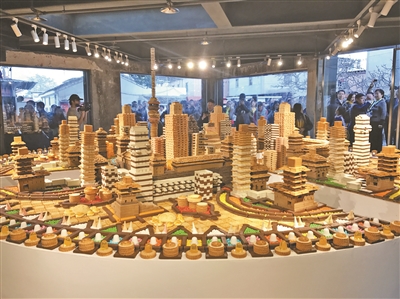
Cao Zhen caozhen0806@126.com THRONGS of Shenzhen villagers swarmed into a sweet and fragrant room where a neatly-stacked city installation made up of biscuits, wafers and candies took up almost the entire space. Curious adults and excited children grabbed their bites for free and in a few minutes, the whole “city” was gobbled up. Created by Beijing artist Song Dong, who has exhibited similar “biscuit city” installations around the world, the installation “Eating the City” is an exploration of the dramatic growth of cities and the resulting sameness. He invites the public to eat the “city,” thereby partaking in the art piece. “The biscuits and candies are tempting, but eating too many will harm your health. This is similar to the way a city rapidly develops,” explained Song. Song’s installation was exhibited at the “Village As Kitchen” exhibition Dec. 22 in Dameisha Village, Yantian District, the 2017 Bi-City Biennale of UrbanismArchitecture’s Yantian Subvenue. Located on the eastern coast of Shenzhen, the village maintains tile-roofed houses, vegetable gardens and villagers who cook meals in open-air lanes. Eighteen groups of contemporary artists’ paintings, videos and installations are placed directly into the rural spaces. According to the exhibition curators, Liu Heng and Yang Yong, they selected Dameisha Village in Yantian District because in the midst of Shenzhen’s rapid urbanization and the growth of the tourism industry in adjacent areas, the village remains peaceful, undisturbed and dynamic. “To echo the biennale’s theme of ‘Cities, Grow in Differences,’ we selected this historical village and collaborated with villagers and architects to explore a new possibility for the development of urban villages, setting an example for Yantian to follow for integrating art into life,” said Yang at the opening ceremony of the exhibition under a decades-old banyan tree Dec. 22. “Dameisha Village is full of vibrancy and the villagers have given us much inspiration over the past two months of preparation. The village committee provided us with 10 unoccupied houses for the exhibition, which in turn motivated the villagers’ curiosity about art and architecture. I believe it will propel the community’s improvement,” said Liu. Like artist Song said, “eating signifies life itself,” the exhibition sets “food” as its theme to reflect the natural link between food and life. Some architects built a sewage treatment facility or transformed the interior of the house to create better living conditions for villagers, while some set up rooftop farms for villagers to plant vegetables and enjoy the cool air under the green shade of trees. Inside the 10 houses, some artists displayed their works related to cooking or dining, forming an organic flow between food, art and life. Zhao Qian’s painting series “Memorizing Taste” features local Yantian dishes. Xu Qinong presented a literal cultural feast for visitors. She placed five bowl-shaped ceramic sound amplifiers on a round table. When visitors scanned a QR code in front of each bowl, they can watch videos of Yantian life, food and ocean. While most works are housed indoors, the boundaries of the exhibit went beyond the walls. Curator Yang’s installation “Nonlinear,” located at the main square of the village, got its inspiration from piled containers on Yantian Port. National Grand Theater of China’s choreography director Gao Guangjian created a modern dance show under the banyan tree at the exhibition opening to express the coexistence of historic and modern cultures. Visitors are suggested to pick up a map of the exhibition route at the information center after they enter the village with “UABB Meisha” color light boxes at the entrance. Volunteers wearing red jackets are standing at the exhibition houses to offer direction assistance. Even if you are not interested in art, you can still have a lovely afternoon walk in the nice little village. Dates: Until March 3, 2018 Hours: 10 a.m.-6 p.m. (Sun.-Thu.); 10 a.m.-8 p.m. (Fri.-Sat.) Venue: Dameisha Village, Yantian District (盐田区大梅沙村) Metro: Line 2 or 5, Huangbeiling Station (黄贝岭站), Exit D, then take bus 387 and get off at Haibin Yuchang Station (海滨浴场站) | 
